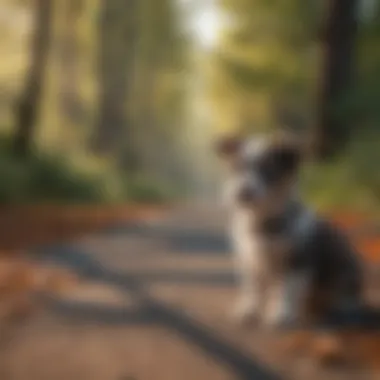Expert Tips on Mastering Leash Training for Your New Puppy


Pet Care Essentials
Caring for a new puppy involves understanding their daily nutrition requirements, ensuring they receive proper exercise and playtime, following grooming tips, and scheduling health and wellness check-ins for optimal care. Proper nutrition is essential to support a puppy's growth and development. Providing a balanced diet with the right mix of nutrients is crucial. Additionally, engaging your puppy in regular exercise and playtime sessions promotes their physical health and mental well-being. Grooming practices like regular brushing, nail clipping, and bathing help maintain your puppy's hygiene. Regular health and wellness check-ins with a veterinarian are vital to monitor your puppy's overall health and address any concerns promptly.
Introduction
Why Leash Training is Crucial
Leash training plays an integral role in not only the safety and well-being of your puppy but also in establishing a strong foundation for obedience and communication. By teaching your puppy to walk calmly on a leash, you are instilling essential skills that will enable them to navigate the outside world with confidence and ease. Furthermore, leash training promotes bonding between you and your puppy, fostering trust and respect in your relationship.
Setting Expectations
Setting realistic expectations is key to a successful leash training journey. It is essential to understand that leash training is a gradual process that requires patience, consistency, and positive reinforcement. Recognize that each puppy is unique and may progress at their own pace. By approaching leash training with a positive mindset and a willingness to adapt to your puppy's needs, you can create a supportive environment that encourages learning and development.
Building a Positive Association
Building a positive association with the leash is paramount to successful training. Introduce the leash gradually, associating it with positive experiences such as treats and playtime. By creating a positive and rewarding connection with the leash, you can help your puppy develop a liking for wearing it and being guided by it. Remember, a positive attitude and gentle encouragement are essential components in building a strong and trusting bond with your puppy during leash training.


Preparing for Leash Training
Leash training is a crucial aspect of a puppy's early development. It sets the foundation for a positive relationship between the pet owner and the puppy while ensuring safety and control during walks. One of the key elements in successfully mastering leash training is adequate preparation. By preparing for leash training, pet owners can address potential challenges, understand their puppy's needs, and establish a routine that fosters learning and adaptation.
Choosing The Right Leash and Collar
When it comes to leash training, selecting the appropriate leash and collar is paramount. The leash should be sturdy yet lightweight, allowing for easy handling and control. A standard six-foot leash is recommended for training sessions, providing enough freedom for the puppy to explore while maintaining proximity to the owner. Collars should fit comfortably around the puppy's neck without being too tight or too loose, ensuring both safety and comfort during training.
Creating a Consistent Routine
Consistency is key when it comes to leash training. Establishing a regular routine helps the puppy understand expectations and promotes positive behavior. Pet owners should schedule training sessions at the same time each day, starting with short walks and gradually increasing the duration. By following a consistent routine, puppies learn to associate the leash with a positive experience and develop good walking habits.
Understanding Your Puppy's Behavior
Understanding your puppy's behavior is essential for successful leash training. Each puppy has a unique personality and may respond differently to training methods. Observing your puppy's body language, reactions to stimuli, and energy levels can provide valuable insights into their needs and preferences. By understanding your puppy's behavior, you can tailor your training approach to suit their individual characteristics, making the learning process more effective and enjoyable for both you and your four-legged companion.
Basic Leash Training Techniques
Leash training is a fundamental aspect of ensuring a well-behaved and obedient puppy. In this article, the focus on Basic Leash Training Techniques is paramount as it forms the foundational knowledge required for successful leash training. By delving into specific elements such as leash introduction, loose leash walking, and addressing pulling and tugging, readers will gain a comprehensive understanding of how to instill good leash manners in their new puppy.


Introducing the Leash Gradually
Introducing the leash gradually to your puppy is a crucial step in ensuring they feel comfortable and secure with this new accessory. This process involves slowly acclimating your puppy to the presence of the leash, starting indoors where distractions are minimal. By taking a patient and gradual approach, you can help your puppy associate the leash with positive experiences, setting the stage for successful leash training sessions in the future.
Teaching Loose Leash Walking
Teaching your puppy to walk on a loose leash is essential for enjoyable walks without pulling or tension. This technique involves rewarding your puppy for walking by your side without pulling on the leash. Through consistent positive reinforcement and praise, your puppy will learn to associate walking calmly on a leash with pleasant experiences. Patience and consistency are key as you guide your puppy towards mastering the art of loose leash walking.
Addressing Pulling and Tugging
Addressing pulling and tugging behavior is a common challenge during leash training. By implementing techniques such as stopping and changing direction when your puppy pulls, you can help them understand that pulling does not lead to forward movement. Consistency and positive reinforcement are essential in retraining your puppy to walk politely on a leash. With practice and patience, you can overcome pulling and tugging behaviors, creating a more enjoyable walking experience for both you and your puppy.
Advanced Leash Training Strategies
In this section focusing on Advanced Leash Training Strategies, we delve into the pivotal aspects that contribute to refining your puppy's leash training experience. Advanced training is crucial in instilling discipline and enhancing the bond between you and your furry companion. By advancing to this stage, you pave the way for more intricate training maneuvers while solidifying the foundational training principles.
Working on Distractions and Commands


When delving into Working on Distractions and Commands, it is imperative to understand that these elements play a paramount role in honing your puppy's leash training skills. Introducing distractions simulates real-life scenarios, preparing your puppy to stay focused amidst various stimuli. This phase helps reinforce obedience and responsiveness to commands, ensuring that your puppy follows instructions even in challenging environments. By mastering these aspects, you establish a strong communication channel with your puppy, fostering mutual understanding and cooperation.
Practicing in Various Environments
Practicing in Various Environments is a pivotal phase that exposes your puppy to diverse settings, enriching their training experience. Transitioning from familiar surroundings to new locations aids in generalizing their training, ensuring that they exhibit desired behavior regardless of the environment. This training approach cultivates adaptability and confidence in your puppy, shaping them into well-rounded and well-behaved companions. Exposure to varying environments instills resilience and flexibility, preparing your puppy for real-world interactions and adventures.
Building Off-Leash Trust
Building Off-Leash Trust marks a significant milestone in your puppy's training journey, signifying a deepened bond and heightened level of trust between you and your pet. This phase involves gradual progression from on-leash to off-leash training, emphasizing reliability and responsiveness without physical restraint. As your puppy demonstrates consistent obedience and understanding of commands, you can gradually introduce off-leash sessions in secure environments. Building off-leash trust is a testament to the strong foundation laid during leash training, showcasing mutual respect and effective communication between you and your beloved companion.
Troubleshooting Common Leash Training Challenges
Embarking on the journey of leash training your new puppy comes with various challenges that may arise along the way. It is crucial to address these issues effectively to ensure a successful training experience. Troubleshooting common leash training challenges is a vital aspect of this article, as it equips pet owners with the knowledge and skills needed to overcome obstacles and ensure a smooth training process. By highlighting specific elements such as identifying problem behaviors, implementing corrective measures, and maintaining patience and consistency, this section delves deep into navigating the common hurdles that pet owners may encounter during leash training.
Dealing with Fear or Anxiety
Addressing fear or anxiety in puppies during leash training is a significant concern for pet owners. This section provides valuable insights into understanding the underlying causes of fear or anxiety, such as past traumatic experiences or lack of socialization. By emphasizing the importance of creating a safe and positive training environment, gradually exposing the puppy to the new experience, and using positive reinforcement techniques, pet owners can help their furry companions overcome fear or anxiety associated with leash training. Practical tips and compassionate guidance are offered to help pet owners navigate this sensitive issue with empathy and care.
Correcting Unwanted Behaviors
Unwanted behaviors such as pulling, lunging, or resisting the leash are common challenges faced during leash training. This section delves into effective strategies for correcting these behaviors, including redirecting attention, reinforcing desired behaviors, and using gentle corrective methods. By understanding the root causes of unwanted behaviors and implementing consistent training techniques, pet owners can help their puppies develop good leash manners and obedience. Practical examples and step-by-step guidance are provided to empower pet owners in addressing and correcting unwanted behaviors in a positive and constructive manner.
Seeking Professional Help
In some cases, pet owners may encounter complex issues or obstacles during leash training that require professional assistance. This section explores the benefits and considerations of seeking help from certified animal behaviorists or trainers. By recognizing when expert guidance is needed, pet owners can ensure the well-being and progress of their puppies in the training process. The importance of finding a reputable professional, communicating effectively about training goals, and actively participating in the training sessions is highlighted to maximize the effectiveness of seeking professional help. Practical recommendations and insights are shared to guide pet owners in making informed decisions when considering professional assistance for addressing specific challenges in leash training.







